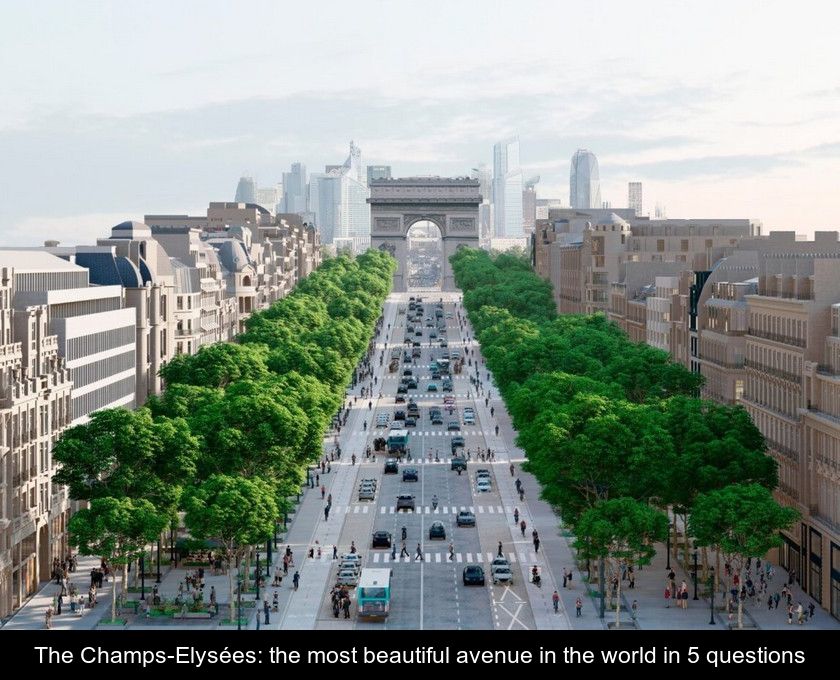The Champs-elysées: The Most Beautiful Avenue In The World In 5 Questions
An iconic place in the capital, the Champs-Elysées is an unmissable tourist site, with its luxury shops and famous monuments. This avenue, dear to the hearts of the French for hosting major popular gatherings during historical or sporting events, had lost its appeal over time. But a major renovation project could soon make this artery of Paris greener, safer, and more attractive. Here’s what you need to know about the most beautiful avenue in the world in 5 questions.
1- Where are the Champs-Elysées located?
The Champs-Elysées is undoubtedly the most famous avenue in Paris and one of the most prestigious.
This major artery, located in the 8th arrondissement, connects the Place de la Concorde and its famous Obelisk to the Place Charles-de-Gaulle (formerly Place de l'Étoile) at the center of which stands the Arc de Triomphe.
This grand Parisian avenue stretches from east to west over 1910 meters in length and 70 meters in width. It takes its name from Greek mythology, in which the Elysian Fields were the resting place of virtuous souls after death.
2- Why are the Champs-Élysées famous?
The Champs-Elysées owe their international renown to the prestigious brands represented there, from Vuitton to Ladurée, including the Lido and Fouquet's.
This avenue is also world-famous for its straight layout and the long perspective it offers from the Louvre palace to the Arche de la Défense.
It constitutes not only the historical axis of western Paris but also one of the most renowned tourist spots in the capital, thanks notably to the proximity of the Marigny theater, the Petit Palais, and the Grand Palais.
3- Who designed the Avenue des Champs-Élysées?
This artery was designed by Le Nôtre at the request of Louis XIV at the end of the 17th century to beautify and extend the perspective from the Tuileries Palace. It was named the Champs-Elysées in 1709.
During the 18th century, the Duke of Antin extended this avenue to the Etoile, and the Marquis of Marigny to the Neuilly bridge. By the end of the 19th century, the Champs had become a popular promenade.
Today, the Avenue des Champs Elysées is extended by the perspective of the Grande Arche de la Défense. The Terrace of the Arc de Triomphe is a privileged site for an overall view of this famous Parisian artery.
4- What events have marked the history of the Champs-Élysées?
The Champs-Élysées are also known for having been the stage of major French historical events, notably the Liberation parade with General de Gaulle and the Allied troops in 1944.
Since then, the descent of the Champs-Élysées has been an honor reserved for foreign heads of state, celebrations of sports victories, and manifestations of popular jubilation, such as during the 1998 Football World Cup.
On the national holiday, July 14th, the main military parade of France takes place there. This avenue is also the finishing point of the last stage of the Tour de France cycling race.
Finally, every December 31st, during New Year's Eve, the Champs-Élysées become accessible to pedestrians to celebrate the arrival of the new year.
5- What could the Champs-Élysées of the future look like?
On May 27, 2024, the Champs-Élysées Committee presented 150 proposals to re-enchant the nearly 2-kilometer-long famous artery and restore its title as the most beautiful avenue in the world. This monumental project, estimated at around 250 million euros, includes, among other changes, the development of an additional hectare of pedestrian and landscaped area.
To make this avenue more attractive, especially for pedestrians, architect Philippe Chiambaretta, commissioned by the Champs-Élysées Committee, proposes to bring more nature and culture to the 1910 meters that connect Concorde to the Arc de Triomphe. In his project, the sidewalks would be widened to provide 13% more space for pedestrians.
The avenue would become greener, safer, and more accessible to walkers. It would offer a more attractive setting for strolling but also for lingering and enjoying various activities and services, such as green lounges, kiosks, and restrooms. In short, it would undergo a true metamorphosis, capable of bringing Parisians back to their most famous avenue...









